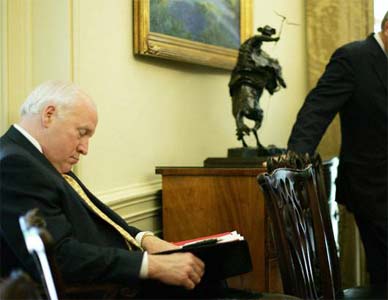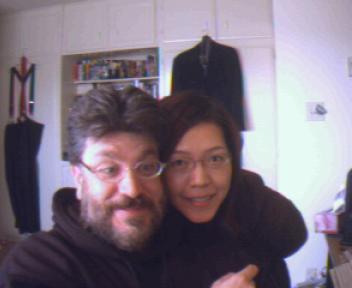Wed, Apr. 26, 2006: Associated Press' HANS GREIMEL: Last Ninja: 'Be able to kill your students'

NODA, Japan - The teachings of Grand Master Masaaki Hatsumi echo through my head as he entreats me to attack a blackbelted disciple with a practice sword. "Always be able to kill your students," he says.
Chilling words from a shockingly fit 76-year-old man who bills himself as the world's last ninja and stocks his training chamber with weapons such as throwing stars and nunchucks. Especially to a neophyte whose closest brush with martial arts was watching Bruce Lee matinees as a kid.
As I cautiously raise the sword with a taut two-handed samurai grip, my sparring partner gingerly points to Hatsumi. I avert my eyes for a split second - and WHAM! The next thing I know, I'm staring at the rafters.
Keeping your focus is just one of the lessons thumped out on the mats of the Bujinkan Dojo, a cramped school outside Tokyo that is a pilgrimage site for 100,000 worldwide followers. They revere Hatsumi as the last living master of ninjutsu - the mysterious Japanese art of war practiced by black-masked assassins of yesteryear.
"He's unlimited in body, mind and spirit," says Richard VanDonk, who flew in from California to practice body throws in the dojo's warm glow of rice-paper screens and flickering votive candles. "He's a master of change."
Hatsumi is the only living student of the last "fighting ninja," Toshitsugu Takamatsu, the so-called 33rd Grand Master who was a bodyguard to officials in Japanese-occupied Manchuria before World War II and fought - and won - 12 fights to the death. Legend says that during one battle, Takamatsu snatched an eyeball from a would-be Chinese bandit.
Today, Hatsumi's enemies are stereotypes and flagging interest in the ancient art. He seeks to leave the task to a worthy successor as speculation mounts about his retirement.
In many ways, the curly-haired, wide-eyed Hatsumi has been a victim of success: He has helped make ninja an international household name by training followers from Chile to South Africa. But he also has watched his legacy co-opted by goofy caricatures such as "Mutant Ninja Turtles" and schlocky Hollywood send-ups like "Beverly Hills Ninja."
"I think it's pathetic," Hatsumi says of the ninja's modern image.
A glance around the dojo suggests the average Japanese might agree. The vast majority of students are foreigners, often with a military background, who learned of Hatsumi overseas. That's because in Japan, ninjutsu is swept up in the wave of apathy that has sapped the ranks of traditional martial arts like sumo and judo.
Most Japanese are exposed to martial arts in school. But the number practicing judo has been declining since the 1980s as more people turn to Western sports like golf and tennis. Sumo also has fallen on hard times, forcing the Japan Sumo Association to import stars.
"Young kids might be more interested in other sports that are flashy or fashionable," concedes Makinori Matsuo, an associate professor of martial arts at Tokyo's International Budo University.
"They tend to be turned off by the image of martial arts as sweaty and smelly," he said.
Ninja is a compound word from the Japanese characters for "stealth" or "endurance" and "person," a reference to their traditional role as spies, mercenaries and assassins working for medieval warlords.
Traditional weaponry such as swords and throwing stars feature prominently is Hatsumi's lessons, as do handclaws for climbing walls, blow darts and chili pepper dust to throw in an opponent's eyes.
But true ninjutsu, Hatsumi says, is self-discipline and balance in the boardroom and the battlefield. It's about mastering one's weaknesses, including laziness and fear, and exploiting a rival's needs, such as sex and pride.
As he nimbly glides across the padded floor, Hatsumi showers students with cryptic proverbs straight out of Confucian scrolls, such as "anything can be used as a weapon" or "ninjutsu is the sum of things in the universe."
"Timing is the most difficult," he adds, while casually deflecting a gleaming metal sword swung at his neck by a veteran student. After the turning the blade on the attacker, Hatsumi gives his arm a slight twist, eliciting a baleful yelp.
Halfway through the lesson, Hatsumi takes a break to pen traditional brush paintings for students who hustle to his side with paper. Then things get serious again with the meting out of "ninja tests."
Going for his fifth-level ranking is Phil White of England, who kneels on the floor with his eyes closed. Behind him stands Hatsumi, clutching a padded wooden sword that he plans to bring down on White's head.
If White - with his eyes still closed - manages to dodge the sword, he passes; if not, he takes home some bumps.
Twice the staff cracks on White's head before he slumps out of the way on his third try - enough to satisfy the master.
"I'm still shaking," White says afterward, while being barraged by congratulatory slaps on the back. "I didn't feel like I was moving. You feel like you're being blown by the wind."
Today, hundreds of ninja schools across Europe, North America and beyond trace their roots to Hatsumi.
He has held training seminars for the FBI, CIA, the Mossad and for police in Britain, France and Germany. He has served as a martial arts adviser to films such as the James Bond thriller "You Only Live Twice" and the television miniseries "Shogun."

Hatsumi has left his mark in other ways, authoring a dozen books in English and Japanese.
He says he is not ready to sheath his sword anytime soon, but admits the question of who will succeed him as ninjutsu's world leader is a constant topic of gossip at the dojo. Only Hatsumi gets to choose the next grand master, and he's not giving any hints.
It's even possible it will be a non-Japanese for the first time, he says.
"Human beings always want to know what they cannot know," he says. "But you can never tell the future."
---
Associated Press writer Kana Inagaki contributed to this report from Tokyo.
ON THE NET: www.bujinkan.com/
Masaaki Hatsumi
Masaaki Hatsumi (初見良昭 Hatsumi Masaaki, born December 2, 1931) is the founder and current headteacher of Bujinkan Dojo martial arts organization.He graduated from Meiji University in Tokyo with a major in theater production, and later opened his own chiropractic clinic in Noda city.
From his childhood he studied many martial arts, including judo and western boxing. During this time, he was instructing American soldiers in the art of judo, and noticed because of size and strength superior to his Japanese comrades, they were learning in months what typically took a Japanese judoka years to master. In this, he began to question himself and his training. It was after this time, he began studying ancient kobudo weaponry under Toshitsugu Takamatsu.
In 1957 he began making his weekly trips to train with his new teacher in Kashiwabara, taking a train ride some several hours one way. He did this every weekend, and was able to train as often as possible with his sensei.
From Takamatsu he inherited the position of sōke (headmaster) of 9 ryū (schools of martial arts):
- Togakure-ryū Ninpō Taijutsu (戸隠流忍法体術)
- Gyokko-ryū Kosshijutsu (玉虎流骨指術)
- Kuki Shinden Happō Bikenjutsu (九鬼神伝流八法秘剣術)
- Kotō-ryū Koppōjutsu (虎倒流骨法術)
- Shinden Fudō-ryū Dakentaijutsu (神伝不動流打拳体術)
- Takagi Yōshin-ryū Jūtaijutsu (高木揚心流柔体術)
- Gikan-ryū Koppōjutsu (義鑑流骨法術)
- Gyokushin-ryū Ninpō (玉心流忍法)
- Kumogakure-ryū Ninpō (雲隠流忍法)
Masaaki Hatsumi first came to the attention of the western world when his student Stephen K. Hayes began appearing in martial art magazines in the late 1970s. The techniques that Hayes demonstrated in these magazines were then referred to simply as the techniques of the Ninja. Westerners craving knowledge about these ancient systems of self defense saught out the teacher of Hayes and, thus, Hatsumi-sensei was introduced to the west. He first came to the United States in 1983. He later traveled and taught throughout Europe.
In the 1990s Hatsumi-sensei began teaching the nine schools under the banner of Bujinkan Budo Taijutsu. His training began to move from the pre-arranged kata and henkas, to teaching to grasp the feeling of a technique instead, to try to feel what makes a technique work under the most dire of situations. This principle is called shinkengata, and represents life/death situations.
His Bujinkan system is comprised of the nine ryū (schools) listed above, and has a ranking system as follows:
Mukyu (commonly called 10th kyu) - White Belt 9th - 1st Kyu - Green Belt (Red and White Patch) 1st - 4th Dan - Black Belt, Shidoshi-ho (Black and Red Patch with Stars) 5th - 9th Dan - Black Belt, Shidoshi (Black and Red Patch with White Border, and Stars) 10th - 15th Dan - Black Belt, Shihan (Green and Orange Patch, with Stars)
Some of his more well-known senior students include:
- Sean Askew 10th Dan, Kentucky
- Charles Daniel 8th Dan, Georgia
- David Dow 10th Dan, California
- Pedro Fleitas 15th Dan, Spain
- Jack Hoban 15th Dan, New Jersey
- Stephen K. Hayes 10th Dan, Founder of Toshindo and Quest Centers, Ohio
- Phil Legare 15th Dan, 10th Dan Shinkenjutsu, Japan
- Bud Malmstrom 10th Dan, Georgia
- Bonnie Malmstrom 10th Dan, Georgia
- Fumio Manaka 10th Dan, Founded the Jinenkan Dojo in 1996, Japan
- Joe Maurantonio 10th Dan, New York
- Ed Martin 15th Dan, Pennsylvania
- Jeff Mueller 10th Dan, Maryland
- Glenn J. Morris 9th Dan, Soke, Hoshinjutsu, Texas
- Bo Munthe 9th Dan, first European to spread Ninjutsu in Europe. Sweden
- Toshiro Nagato 15th Dan, Japan
- Isamu Shiraishi 15th Dan, Japan
- Shoto Tanemura 8th Dan, Founded Genbukan Dojo in 1984, Japan
- Richard Van Donk 15th Dan, Soke of Decuerdas Escrima, California
- Morgan Brin 15th Dan, Manchester
- Roy Wilkinson 11th Dan, Georgia
- Greg Kowalski 14th Dan, Connecticut
Wheee! I can do that - ZPD

